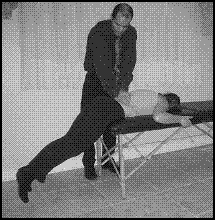Prone Instability Test
Reference:Hicks GE, et al Preliminary development of a clinical prediction rule for determining which patients with low back pain will respond to a stabilization exercise program. Arch Phys Med Rehabil. 2005 Sep;86(9):1753-62.
The Prone Instability Test has been shown to have good inter-rater reliability and reasonable sensitivity (0.72), meaning if the test is negative, a positive response to stabilization is less likely!
Step 1: The patient lays only half way up the bed, with the hips flexed, the trunk muscles relaxed and the feet resting on the floor. A PA pressure is applied over the most symptomatic spinous process.
Step 2: The PA pressure is let go and the patient is requested to slightly lift the feet off the floor. The patient requires holding on to the sides of the bed for support as this will produce a co-contraction of the global abdominal, gluteal and erector spinae muscles.
Step 3: The PA pressure is re-applied over the same level spinous process. If a dramatic reduction or the complete elimination of the symptoms is noted compared to step 1, it is considered a positive prone instability test.
Posted on: December 15, 2011
Categories: Lumbar Spine


